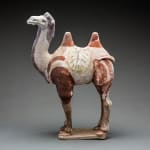Tang Sculpture of a Camel, 618 CE - 906 CE
Terracotta
35.6 x 24.1 cm
14 x 9 1/2 in
14 x 9 1/2 in
TF.019
Further images
The T’ang Dynasty was an era of unrivalled wealth and luxury. The country was successfully reunified and the borders were expanded, pushing Chinese influence into new lands. Confucianism became a...
The T’ang Dynasty was an era of unrivalled wealth and luxury. The country was successfully reunified and the borders were expanded, pushing Chinese influence into new lands. Confucianism became a semi-religious instrument of the state; yet Buddhism continued to flourish, spreading into Korea and Japan. The arts reached new levels of sophistication. Poetry and literature flourished under the enlightened rulers. The Silk Road brought fortunes into China. Precious treasures were imported on the backs of camels from far away lands and bartered for Chinese silk, medicinal herbs, and pungent spices. T’ang China was a multicultural empire where foreign merchants from across Central Asia and the Middle East settled in the urban centers, foremost among them the thriving capital of Chang’an (modern X’ian), a bustling cosmopolitan center of over two million inhabitants. Foreign traders lived next to native artisans and both thrived. New ideas and exotic artistic forms followed alongside. The T’ang Dynasty was a cultural renaissance where many of the forms and objects we now associate with China were first created. Moreover, this period represents one of the greatest cultural outpourings in human history.
As new philosophical and religious strands penetrated the thought system of early China, the subject matter of tomb objects and tomb patterns changed. The past practice of entombing elite members of society with earthenware objects continued throughout the early and middle Tang period, but the earlier emphasis placed on recreating daily life shifted to flaunting status and excess. Tombs were no longer "underground houses," but became a landscape with murals depicting the palaces, gardens, and open countryside in which the nobles passed their lives. During the Tang Dynasty, restrictions were placed on the number of objects that could be included in tombs, an amount determined by an individual's social rank. In spite of the limitations, a striking variety of tomb furnishings have been excavated. Entire retinues of ceramic figures - animals, entertainers, musicians, guardians - were buried with the dead.
During the Tang Dynasty, the status of the beloved camel ranked second only to the revered horse. Camels symbolized commerce and its associated wealth, profits made possible primarily through the legendary Silk Road. Trade across this extensive network of paths and trails brought prosperity, foreigner merchants, and exotic merchandise into China, connecting the Mediterranean world with the Far East. However, this arduous journey through the jagged mountains and rugged deserts of Central Asia could only be undertaken by the two-humped Bactrian camel, a beast able to withstand the scorching heat of the desert and to maintain its own nutrients, surviving for months without fresh supplies of water. The government kept vast herds of these invaluable creatures, presided over by civil officials, for hauling their precious silk supplies across the Silk Road. These exotic creatures were a common sight in the cosmopolitan cities of Tang China, carrying both traders and their goods directly into the markets. Likewise, T’ang artist began to create charming representations of these prized creatures as symbols of the wealth and prosperity to come in the afterlife.
As new philosophical and religious strands penetrated the thought system of early China, the subject matter of tomb objects and tomb patterns changed. The past practice of entombing elite members of society with earthenware objects continued throughout the early and middle Tang period, but the earlier emphasis placed on recreating daily life shifted to flaunting status and excess. Tombs were no longer "underground houses," but became a landscape with murals depicting the palaces, gardens, and open countryside in which the nobles passed their lives. During the Tang Dynasty, restrictions were placed on the number of objects that could be included in tombs, an amount determined by an individual's social rank. In spite of the limitations, a striking variety of tomb furnishings have been excavated. Entire retinues of ceramic figures - animals, entertainers, musicians, guardians - were buried with the dead.
During the Tang Dynasty, the status of the beloved camel ranked second only to the revered horse. Camels symbolized commerce and its associated wealth, profits made possible primarily through the legendary Silk Road. Trade across this extensive network of paths and trails brought prosperity, foreigner merchants, and exotic merchandise into China, connecting the Mediterranean world with the Far East. However, this arduous journey through the jagged mountains and rugged deserts of Central Asia could only be undertaken by the two-humped Bactrian camel, a beast able to withstand the scorching heat of the desert and to maintain its own nutrients, surviving for months without fresh supplies of water. The government kept vast herds of these invaluable creatures, presided over by civil officials, for hauling their precious silk supplies across the Silk Road. These exotic creatures were a common sight in the cosmopolitan cities of Tang China, carrying both traders and their goods directly into the markets. Likewise, T’ang artist began to create charming representations of these prized creatures as symbols of the wealth and prosperity to come in the afterlife.





